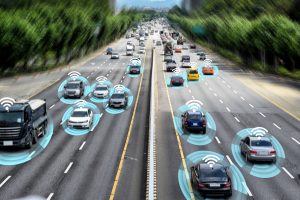
Autonomous Vehicles (AVs) introduce a potentially disruptive and highly beneficial dimension to transportation networks. AVs’ major social impacts can be quantified in the form of collision savings (driver errors are the main reason for 90% of the collisions), travel time reductions (thanks to platooning or autonomous intersection management), and fuel efficiency (through smoother accelerations and reduced braking). Wireless communications play a crucial role in obtaining such challenging objectives, extending the capabilities of AVs. Vehicle-to-vehicle (V2V) and vehicle-to-infrastructure (V2I) communications allow for a better understanding of the surroundings, enabling collaborative efforts, improving safety, and providing intelligent use of the road infrastructure via traffic (re)routing. This is also true when human drivers are involved and, thanks to communication, Artificial Intelligence (AI) can be used to assist Connected Vehicles (CV) and improve the safety of nowadays transportation networks.
The aforementioned CV/CAV systems present extreme dynamicity and require very tight control procedures. Typically, vehicles exploit on-board sensor readings and make use of direct wireless communications in order to coordinate with each other. Recent research comparisons between IEEE 802.11p V2V and the standard LTE (non-V2V) network for vehicular transmissions show that cellular networks are suitable in all case studies, i.e., even in crowded urban environments, due to higher capacity, coverage, penetration, and transmission reliability with respect to V2V. Apart from the technical advantages of the physical layer, the cellular networks of the future will also help vertical industries create new business models and update their industry processes. Cellular networks will be marked, to a great extent, by the collection of components and systems needed to handle the requirements of existing and future use cases. In this sense, two of the most important innovations will be: (i) the dramatic reduction of network latency; and (ii) the possibility to have service portability thanks to the presence of computational capabilities at the edge, i.e., utilizing the Multi-Access Edge Computing (MEC) platform.


Exploiting the heightened awareness arising not only from on-board sensors but also from prompt and elaborated information provided by the mobile infrastructure, this research proposal focuses on Connected – Autonomous – Vehicles Orchestrated with Intelligent Decisions (C-AVOID) and aims at unveiling the potentials for CV/CAV safety provided by the next-generation MEC-enabled cellular networks. The focus will be on two critical use-cases:
- Collision avoidance exploiting the modeling of human driver maneuvers through the collection at the edge of historical vehicle data;
- Autonomous vehicle coordination at dangerous road areas, e.g., intersections, accounting for vehicle location uncertainty.
In order to tackle such challenging use cases, C-AVOID will propose a generic framework for vehicle 2D trajectory estimation that can be applied to CVs/CAVs in different situations, i.e., in highway sectors, ramps, or crossroads. The framework includes the profiling of the typical controls applied by vehicles, e.g., acceleration, braking, and steering, for kinematics estimation. The analysis will account for the mismatch between foreseen and actual effects of vehicle controls and will make use of (inaccurate) localization measurements and historical data to adjust vehicle positioning errors. The proposed algorithms will be tested against a real implementation of a full-fledged MEC-enabled cellular deployment. In order to meet, even in very dense scenarios, the tight QoS requirements of such safety transportation applications, event-triggering techniques that reduce the exchange of messages among entities, hence, the computational processing required, will be utilized.
